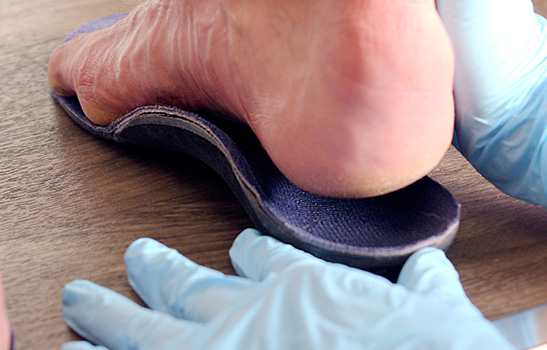Unequal leg length
Most people have one leg that is longer than the other, but the difference is usually so slight that it goes unnoticed. However, if leg length is important (over 5 mm), your posture may be seriously impacted, causing chronic pain.
See the causes See the long term complications See how to relieve yourself at home
Signs and symptoms of unequal leg length
Patients with significantly unequal leg length may experience :
- Pain on one side only ( ex; big toe, arch or heel of one foot only)
- Asymmetrical foot shape (bunions on one foot only)
- Asymmetrical fallen arches
- Asymmetrical wear and tear of shoes
- Knee pain, often on one side only
- Lower back pain (one or both sides)
- Sciatica
- Lumbar disc herniation
- Hip pain, often on one side only
- Targeted pain or “knot” in one shoulder
- Asymmetrical running style (circumduction of one foot, asymmetrical arm swing)
What are the causes of unequal leg length
There are two types of leg length discrepancy: structural and functional. 5 mm and more is considered a clinically significant difference.
Structural leg length discrepancy refers to a difference in femur and/or tibia length. This difference typically arises when bones are still growing. It may be an inherited trait or caused by trauma (such as breaking your leg as a child). In adults, unequal leg length can occur if you break a leg or undergo hip, knee or ankle surgery and end up with a shorter bone on one side.
Functional leg length discrepancy is caused by asymmetrical posture. Asymmetrical posture can artificially shorten one leg. It can be caused by a fallen arch on one foot, knee flexion (osteoarthritis or post-surgery), a misaligned pelvis or scoliosis. Functional leg length discrepancy causes the same symptoms as structurally unequal legs.
Progression and consequences of unequal leg length
Good posture starts with your feet. If one arch falls substantially, an artificial difference in leg length occurs and your entire lower limb becomes misaligned. The misalignment triggers a domino effect: the ankle turns inward, which leads to the excessive internal rotation of the shin and knee. Since the knee connects to the hip via the femur, the pelvis rotates inward and causes strain on your back. Your pelvis will also dip lower on the side of your flat foot.
That’s why leg length discrepancy leads to asymmetric pain.
Patients sometimes complain of pain in the inner ankle or knee, sensitivity in the outer hip and lower back pain. For example :
- Iliotibial band syndrome
- Sciatica
- SI joint blockage
- Herniated discs and disc bulges
- Knee tendonitis
Over the years, abnormal posture can cause premature wear and tear on joints, contributing to arthritis of the foot, knee, hips or back.
Unequal leg length can also cause you to put more weight on one foot, resulting in additional stress and problems on that side of the body. For example, you might have pain in one heel or develop a larger bunion (hallux valgus) on one foot.
Of course, leg length discrepancy affects your gait. Since stride length differs on each side, you may raise one heel prematurely, flex one knee too much or experience an internal rotation of your foot, knee or hip. These problems can lead to :
How to relieve unequal leg length at home
Do not add lifts inside or outside your shoes before having your legs measured by a professional.
However, if you experience foot pain and suspect it is caused by unequal leg length, you’ll find helpful tips in the Foot Pain section.
How to diagnose unequal leg length
- Your podiatrist will perform a thorough biomechanical exam to gain a better understanding of your condition and determine the cause of your leg length discrepancy. This includes reviewing your health history, assessing each segment of your lower limbs, evaluating your posture and performing a camera-assisted plantar pressure analysis. Find out more
- Standing foot x-rays are used to see the angles of your foot bones. Each degree of difference creates asymmetry between your feet. X-rays can also show your joints, bone length and congruence. Find out more
- Scanograms are used to confirm structural leg length discrepancy. The process involves taking a series a three x-rays of your hips, knees and ankles while you lie down with a graduated ruler under your legs. Scanograms can provide accurate measurements of your femur and tibia bones, without the length being affected by a curved spine or flat foot.
- Standing pelvic x-rays are used to confirm functional leg length discrepancy. Typically performed after a scanogram, standing pelvic x-rays are used to determine whether your pelvis is tilted due to an incorrectly positioned foot, knee, hip or back.
- Scanograms and standing pelvic x-rays are used in combination to correctly diagnose structural and functional leg length discrepancy.
What can my podiatrist do about unequal leg length?
1. Biomechanical exam and foot x-rays :
Standing foot x-rays are used to see the angles of your foot bones. Each degree of difference creates asymmetry between your feet. X-rays can also show your joints, bone length and congruence. Find out more
2. Plantar orthotics :
Plantar orthotics are used to realign the feet, knees, hips and lower back. Orthotics also help restore proper biomechanics, reducing stress in the tendons, ligaments and joints.
3. Prescription of a scanogram and standing pelvic x-ray :
Scanograms are used to confirm structural leg length discrepancy. The process involves taking a series a three x-rays of your hips, knees and ankles while you lie down with a graduated ruler under your legs. Scanograms can provide accurate measurements of your femur and tibia bones, without the length being affected by a curved spine or flat foot.
4. Lift for short leg :
A lift may be included in your orthotics or shoe for your shorter leg.
How to prevent unequal leg length?
The best way to prevent joint pain and degeneration associated with leg-length discrepancy is to take preventive measures. If you suspect misalignment in your feet or posture, we strongly advise you to see a podiatrist, who will determine whether treatment is needed and establish a personalized plan.
No one’s legs are exactly the same. It’s no big deal!

It’s true that most people have slightly unequal legs. However, if the difference is 5 mm or more, your posture can be affected, causing pain and eventually leading to permanent structural damage.
What if it’s not leg length discrepancy?
- Asymmetrical or tilted pelvis
- Scoliosis (curvature of the spine)
Other problems can cause the same symptoms and issues as leg length discrepancy:
- Flat feet
- Flexible cavus foot (false flat foot)
- Morton’s foot
- Compensated metatarsus adductus
- Flexible anterior cavus foot (pseudo-equinus)


